Boron is an essential micronutrient needed by peanut to prevent "hollow heart" and to provide for sufficient plant growth (2). Most of Florida's peanut crop is grown on deep, coarse, sandy soils that have low cation exchange capacity (CEC). Boron's high water solubility, high plant availability, low nutrient requirement, and potential to be a toxic element at a relatively low soil concentration make it a challenge to manage for peanut production on sandy soils. There may be times when peanut growers, extension agents, and consultants find field symptoms when either boron toxicity or boron deficiency is the cause of peanut yield loss and low kernel quality. The purpose of this document is to review the boron management strategy in Florida, to present some reference information on boron sufficiency and toxicity levels from the literature, and to include reference photographs of field symptoms that can be used by growers and UF/IFAS Extension agents.
The management strategy recommended by the UF/IFAS Extension Soil Testing Laboratory provides two ways to apply boron for peanut production. When a peanut grower submits a soil test coded for the peanut crop, the grower is presented with two options: either use only 0.75 lb of elemental boron per acre in the fertilizer, or only apply 0.5 lb of elemental boron per acre as a foliar spray with the first fungicide application (6). The reasons for recommending these small applications are to avoid applying excess boron and to avoid toxicity. Boron application rates as low as 2.2 to 3.3 lb of elemental boron per acre have caused toxicity and decreased yields in peanuts (3).
Reference information for plant tissue analysis or sufficiency and toxicity levels are summarized in Table 1. The current UF/IFAS recommendation is to sample the entire above-ground portion of the peanut plant (1). With that plant tissue sampling methodology, sufficient boron concentration in the tissue ranges from 20 to 60 parts per million (ppm). The critical level for peanut is 20 ppm (7). At boron concentrations less than 20 ppm, boron deficiency affecting growth and kernel quality in peanut may occur. Reported critical soil analysis values for boron sufficiency using the hot water extraction method on coarse sandy soils in the Southeast US vary and have not been reliable predictors of peanut plant sufficiency. Soil critical levels, using Mehlich-3 extractant, have ranged from 0.05 ppm (2), to 0.2 ppm (3), to 0.5 ppm (5). Currently, plant tissue analysis is the recommended method of monitoring boron in peanut. Boron toxicity in peanut tissue is likely when boron concentration exceeds 100 ppm (3).
Boron deficiency has been only very rarely seen in peanut fields by the authors. In our experience, fields that have been confirmed with boron deficiency have occurred following pastures that have been fertilized only with nitrogen, if at all, with no boron applied in the peanut crop fertilizer. Soils of confirmed boron-deficient fields have typically been well- to excessively-drained sands. Boron deficiency has been corrected in a peanut crop at the mid-bloom stage with a foliar spray application of 0.5 lb of elemental boron per acre. Field symptoms are illustrated in Figures 3, 4, and 5.
Boron toxicity has been seen more often than deficiency in peanut fields by the authors. In our experience, fields that have been confirmed with boron toxicity have been localized areas in the field or field ends as a result of over-application or accumulation. Field symptoms of toxicity are illustrated in Figures 1 and 2. A corrective remedy, if irrigation is available, is to leach the excess boron from the root zone. This corrective action may work if the soil is well-drained. A soil sample for boron can be taken following corrective action to confirm that soil levels are below toxic levels. Successful remediation would be indicated by new peanut foliage growth free of symptoms, because boron is not mobile within the plant (7). For dry-land peanut fields where no irrigation is available for corrective action, a soil test is still recommended to determine the potential for continued toxicity. If boron toxicity was the result of over-application in a foliar spray, the soil levels may be safe for the following peanut or other cropping season. If boron was the result of over-application in the fertilizer, or from over- lapping at row ends, the soil levels need to be known for the following cropping season.
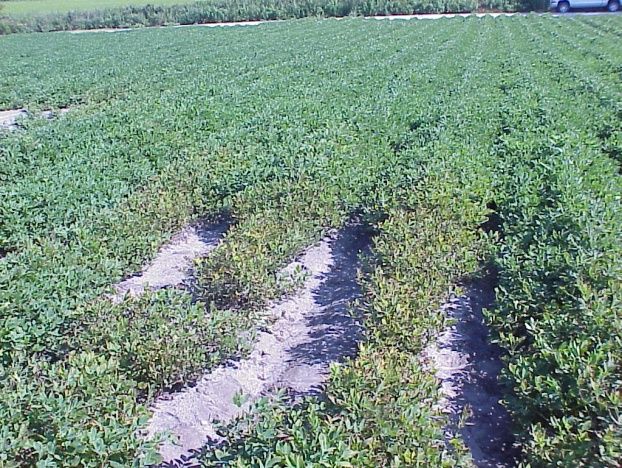
Credit: W. D. Thomas
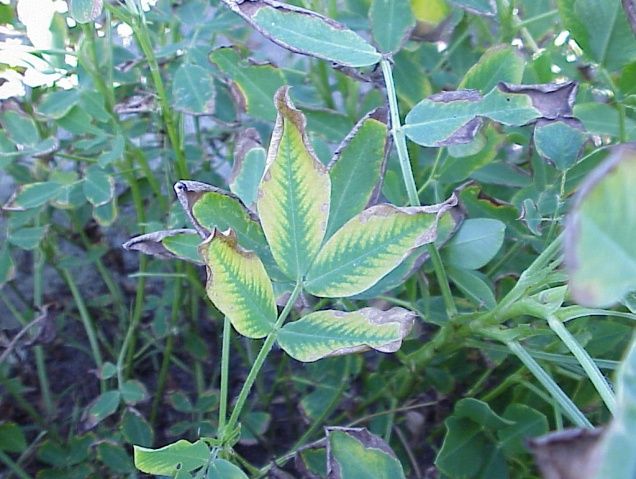
Credit: W. D. Thomas
Classical toxicity symptoms from applying too much boron first present as leaf-tip chlorosis that extends down the margins and between the veins (3). With increasing levels of toxicity, the leaf margins die. Another field toxicity symptom of excessive boron application can result from slowing the tractor down at the end of the rows rather than maintaining constant speed until cutting the sprayer off before turning.
Figure 2 shows classic and severe symptoms in the field of a Florida farm. This localized boron toxicity was caused by a rainfall event (4 to 5 inches), where sheet erosion puddled water and topsoil run-off in lower areas of the field. Boron was probably concentrated in those lower areas through sheet erosion rather than leaching through the soil profile. A tissue sample of these plants showed boron concentration was 1,116 ppm. Published literature suggests boron tissue levels equal to or greater than 100 ppm can be phytotoxic (Table 1).
Classic deficiency symptoms in the field are compacted branch terminals and cracks on stems and pods, dark areas on internodes, mottled leaves, and stubby roots with negligible nut yield (4). Figure 3 features a broad view of a peanut field with these symptoms, Figure 4 provides a close-up of the abnormally compacted plant growth from the same field, and a detail of stem and branch cracking is illustrated by Figure 5. Stem and branch cracking symptoms can remain visible even after harvest to help diagnose boron deficiency, as shown in Figure 6. Although boron is mobile in the soil, it is not mobile within the peanut plant. The lack of mobility within the plant results in these physiological disorders (7).

Credit: H. E. Jowers
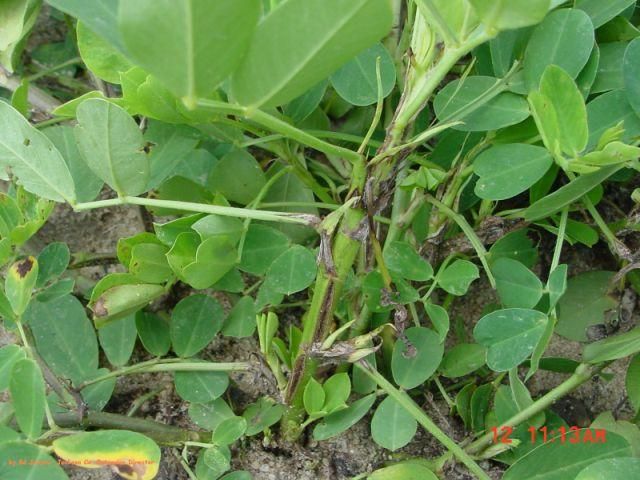
Credit: H. E. Jowers
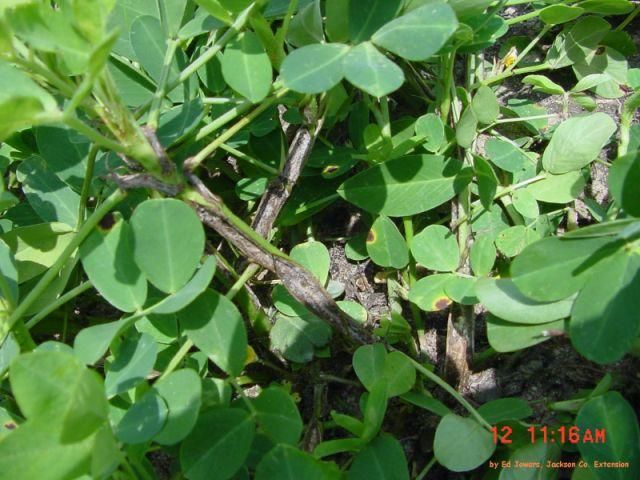
Credit: H. E. Jowers
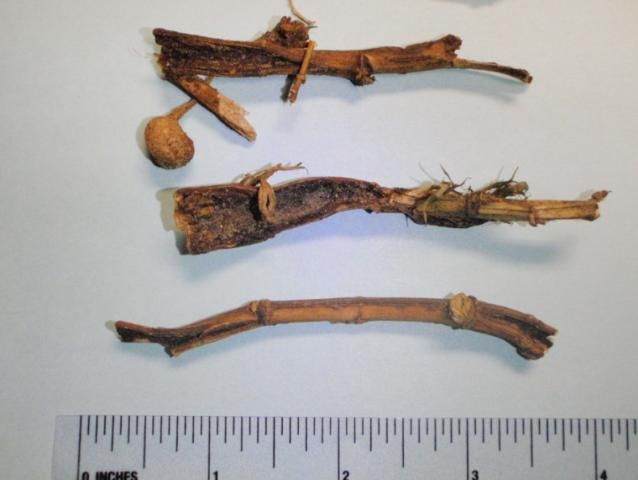
Credit: J. W. Breman
This document provides a summary of currently recommended boron nutrient management for peanuts in Florida (Table 1). The UF/IFAS Extension Soil Testing Laboratory provides a conservative boron management guideline for sufficiency to minimize the chances of developing boron toxicity on our coarse-textured soils. Monitoring boron concentration in peanut plant tissue is recommended. Whole plant-tissue samples more accurately reflect the nutritional status because boron concentration in leaves remains constant during the growth cycle (7). Field symptoms of boron toxicity and deficiency have been provided to show that occasionally, a combination of soil, farming history, the season, and field events may cause peanut yield and/or quality loss.
References
Campbell, C. R., and C. O. Plank. Peanut. In Reference Sufficiency Ranges for Plant Analysis in the Southern Region of the United States (SCSB 394), 2009, 22–23. http://www.ncagr.gov/agronomi/saaesd/scsb394.pdf (no longer available online).
Cox, F. R., F. Adams, and B. B. Tucker. Liming, fertilization, and mineral nutrition. In Peanut Science and Technology, edited by H. E. Pattee and C. T. Young, 1982, 139–163. Yoakum, Texas: American Peanut Research and Education Society.
Gascho, G. J., and J. G. Davis. Mineral nutrition. In The Groundnut Crop: A Scientific Basis for Improvement, edited by J. Smartt, 1994, 214–254. London: Chapman & Hall.
Harris, H. C., and J. B. Brolmann. Effect of imbalance of boron nutrition on the peanut. Agronomy Journal 58 (1): 97–99.
Henning, R. J., A. H. Allison, and L. D. Tripp. Cultural practices. In Peanut Science and Technology, edited by H. E. Pattee and C. T. Young, 1982, 123–138. Yoakum, Texas: American Peanut Research and Education Society.
Mylavarapu, R., D. Wright, G. Kidder, and C. G. Chambliss. UF/IFAS standardized fertilization recommendations for agronomic crops (IPN SL129). 2009. https://edis.ifas.ufl.edu/publication/SS163
Plank, C. O., and D. E. Kissel. Nutrient content of plant. In Plant Analysis Handbook for Georgia (n.d.). http://aesl.ces.uga.edu/publications/plant/Nutrient.html